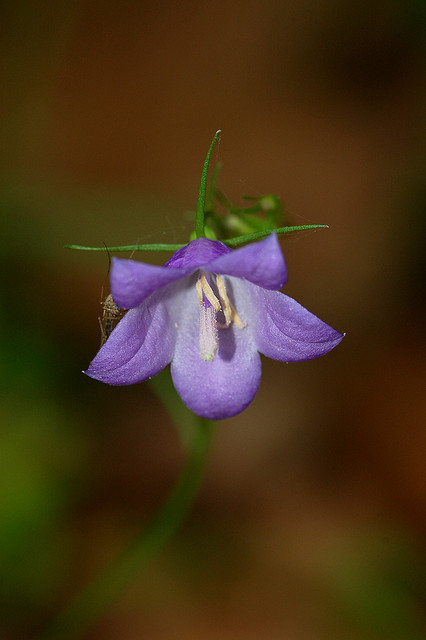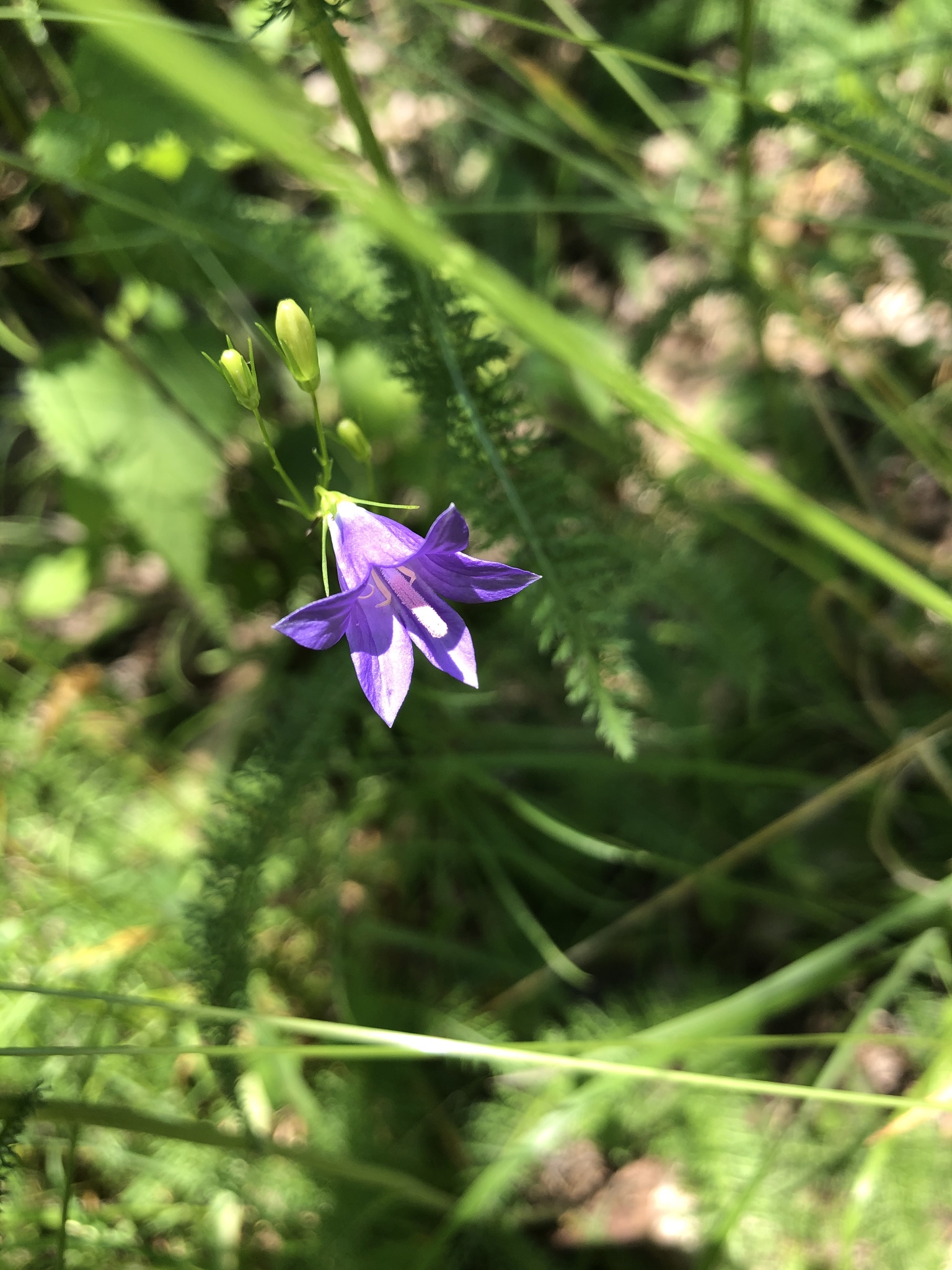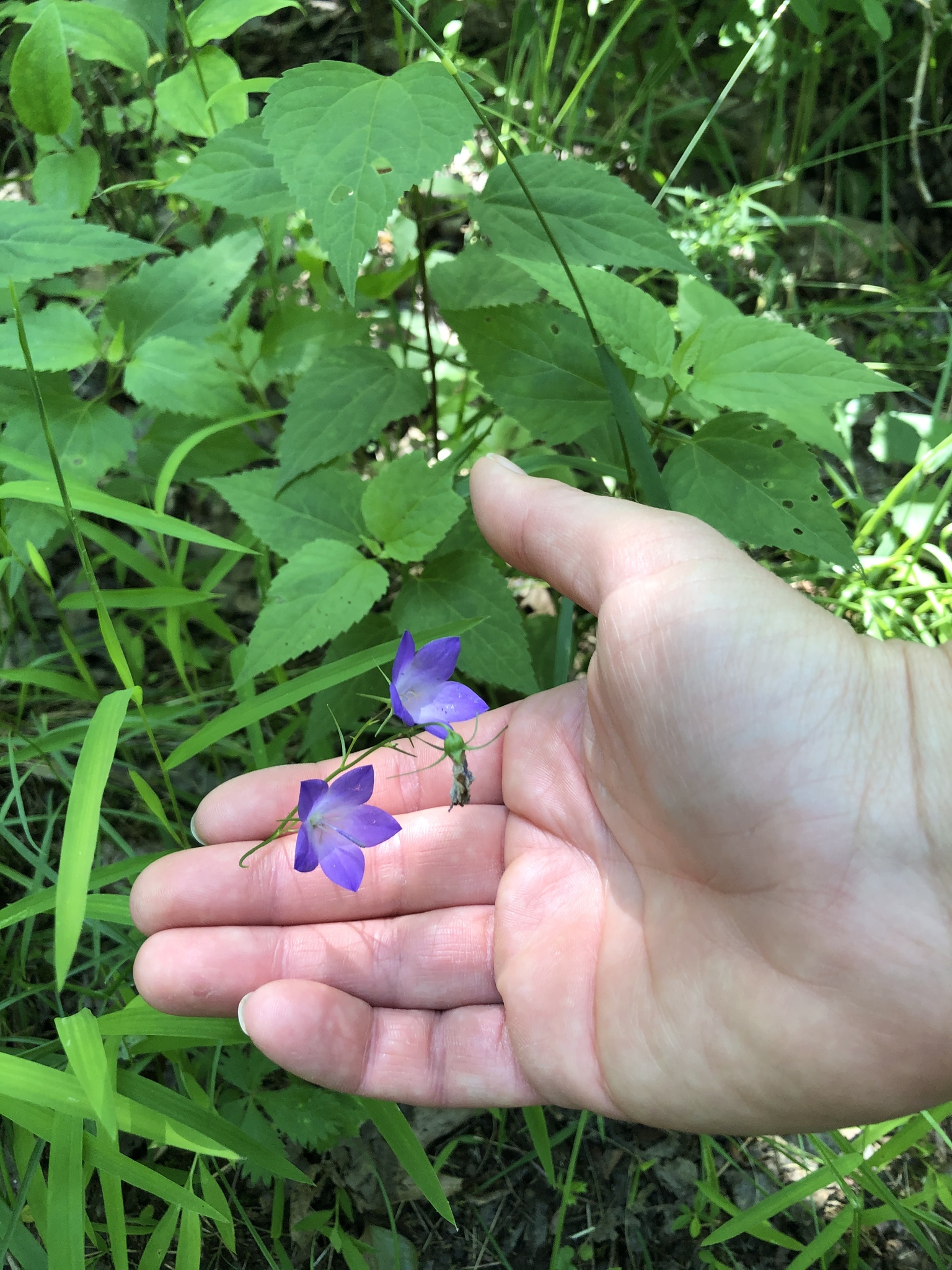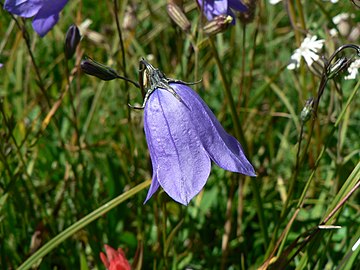Map Snapshot





45 Records
Seasonality Snapshot
Source: Wikipedia
| Campanula rotundifolia | |
|---|---|

| |
| Scientific classification | |
| Kingdom: | Plantae |
| Clade: | Tracheophytes |
| Clade: | Angiosperms |
| Clade: | Eudicots |
| Clade: | Asterids |
| Order: | Asterales |
| Family: | Campanulaceae |
| Genus: | Campanula |
| Species: | C. rotundifolia
|
| Binomial name | |
| Campanula rotundifolia | |
| Synonyms[1] | |
|
Synonymy
| |
Campanula rotundifolia, the common harebell, Scottish bluebell, or bluebell of Scotland, is a species of flowering plant in the bellflower family Campanulaceae.[2] This herbaceous perennial is found throughout the temperate regions of the northern hemisphere. In Scotland, it is often known simply as bluebell. It is the floral emblem of Sweden where it is known as small bluebell.[3] It produces its violet-blue, bell-shaped flowers in late summer and autumn.
The Latin specific epithet rotundifolia means "round leaved".[4] However, not all leaves are round in shape. Middle stem-leaves are linear.[5]: 707
Description
[edit]Campanula rotundifolia is a slender, prostrate to erect herbaceous perennial, spreading by seed and rhizomes. The basal leaves are long-stalked, rounded to heart-shaped, usually slightly toothed, with prominent hydathodes, and often wither early. Leaves on the flowering stems are long and narrow and the upper ones are unstemmed.[6] The inflorescence is a panicle or raceme, with 1 to many flowers borne on very slender pedicels. The flowers usually have five (occasionally 4, 6 or 7) pale to mid violet-blue petals fused together into a bell shape, about 12–30 mm (15⁄32–1+3⁄16 in) long and five long, pointed green sepals behind them. Plants with pale pink or white flowers may also occur.[6] The petal lobes are triangular and curve outwards. The seeds are produced in a capsule about 3–4 mm (1⁄8–5⁄32 in) diameter and are released by pores at the base of the capsule. Seedlings are minute, but established plants can compete with tall grass. As with many other Campanula species, all parts of the plant exude white latex when injured or broken.
The flowering period is long and varies by location. In the British Isles, harebell flowers from July to November.[6][7]: 250 [8] In Missouri, it flowers from May to August;[9] in Minnesota, from June to October.[10] The flowers are pollinated by bees, but can self-pollinate.
Taxonomy
[edit]Campanula rotundifolia was first formally described in 1753 by Carl Linnaeus. As of 2023[update], no varieties or subspecies of Campanula rotundifolia are accepted in Plants of the World Online (POWO).[11] Several species have been previously described as varieties or subspecies of C. rotundifolia:
- Campanula alaskana (Campanula rotundifolia var. alaskana or hirsuta)[12] - Alaskan bellflower
- Campanula giesekiana (C. r. var. dubia or var. groenlandica)[13] - Giesecke's harebell
- Campanula intercedens (C. r. var. dentata or intercedens)[14] - intermediate bellflower
- Campanula kladniana (C. r. subsp. kladniana)[15]
- Campanula macrorhiza (C. r. var. aitanica or alcoiana)[16]
- Campanula moravica (C. r. subsp. moravica)[17]
- Campanula nejceffii (C. r. var. bulgarica)[18]
- Campanula petiolata (C. r. var. petiolata)[19] - western harebell
- Campanula ruscinonensis (C. r. var. ruscinonensis)[20]
- Campanula willkommii (C. r. subsp. willkommii)[21]
Although POWO and World Flora Online (WFO)[22] accept these as separate species, most English language sources do not. For example both the Database of Vascular Plants of Canada (VASCAN) and the USDA Natural Resources Conservation Service PLANTS database (PLANTS) do not accept any of these species as valid or even regard them as valid subspecies.[2][23] This is also the case with authoritative floras such as Flora of Colorado.[24]
While it is now commonly known as harebell or bluebell, it was historically known by several other names including blawort, hair-bell, lady's thimble, witch's bells, and witch's thimbles.[25][26]
Elsewhere in Britain, "bluebell" refers to Hyacinthoides non-scripta, and in North America, "bluebell" typically refers to species in the genus Mertensia, such as Mertensia virginica (Virginia bluebells).
Distribution and habitat
[edit]Campanula rotundifolia occurs from Spitzbergen,[6] extending in mainland Europe from northernmost Scandinavia to the Pyrenees and the French Mediterranean coast.[27] It also occurs on the southern coasts of Greenland, on Iceland and on southern Novaya Zemlya.[27]
Some sources and authorities like the VASCAN and PLANTS do not currently separate out different species for North America.[2][28][23] If using these sources it is widely distributed through North America including all of Canada and most of the United States.
It occurs as tetraploid or hexaploid populations in Britain and Ireland, but diploids occur widely in continental Europe.[29] In Britain, the tetraploid population has an easterly distribution and the hexaploid population a westerly distribution, and very little mixing occurs at the range boundaries.[6]
Harebells grow in dry, nutrient-poor grasslands and heaths. The plant often successfully colonises cracks in walls or cliff faces and stable dunes.[6]
C. rotundifolia is more inclined to occupy climates that have an average temperature below 0 °C in the cold months and above 10 °C in the summer.[30]
In Iceland, research on Campanula rotundifolia has revealed that it is a host of at least three species of pathogenic fungi, Coleosporium tussilaginis, Puccinia campanulae and Sporonema campanulae (and the teleomorph Leptotrochila radians).[31]
In culture
[edit]The harebell is dedicated to Saint Dominic.[citation needed]
In 2002 Plantlife named it the county flower of Yorkshire in the United Kingdom.[32]
William Shakespeare makes a reference to 'the azured hare-bell' in Cymbeline:
- With fairest flowers,
- Whilst summer lasts, and I live here, Fidele,
- I'll sweeten thy sad grave: thou shalt not lack
- The flower that's like thy face, pale primrose, nor
- The azured hare-bell, like thy veins; no, nor
- The leaf of eglantine, whom not to slander,
- Out-sweeten'd not thy breath.[33][note 1]
Christina Rossetti (1830–1894) wrote a poem entitled 'Hope is Like A Harebell':
- Hope is like a harebell, trembling from its birth,
- Love is like a rose, the joy of all the earth,
- Faith is like a lily, lifted high and white,
- Love is like a lovely rose, the world's delight.
- Harebells and sweet lilies show a thornless growth,
- But the rose with all its thorns excels them both.[34]
Emily Dickinson uses the harebell as an analogy for desire that grows cold once that which is cherished is attained:
- Did the Harebell loose her girdle
- To the lover Bee
- Would the Bee the Harebell hallow
- Much as formerly?
- Did the paradise – persuaded
- Yield her moat of pearl
- Would the Eden be an Eden
- Or the Earl – an Earl[35]
Notes
[edit]- ^ In Jessica Kerr's and Opelia Dowden's Shakespeare's Flowers published in 1970 they infer that Shakespeare was actually making reference to Hyacinthoides non-scripta.
References
[edit]- ^ "Campanula rotundifolia". World Checklist of Selected Plant Families. Royal Botanic Gardens, Kew – via The Plant List. Note that this website has been superseded by World Flora Online
- ^ a b c Acadia University, Université de Montréal Biodiversity Centre, University of Toronto Mississauga, University of British Columbia (18 April 2023). "Campanula rotundifolia Linnaeus - Database of Vascular Plants of Canada (VASCAN)". Database of Vascular Plants of Canada (VASCAN). Retrieved 1 May 2023.
{{cite web}}: CS1 maint: multiple names: authors list (link) - ^ "Sveriges nationalblomma". 13 March 2021.
- ^ Harrison, Lorraine (2012). RHS Latin for Gardeners. United Kingdom: Mitchell Beazley. ISBN 978-1845337315.
- ^ Stace, C. A. (2019). New Flora of the British Isles (Fourth ed.). Middlewood Green, Suffolk, U.K.: C & M Floristics. ISBN 978-1-5272-2630-2.
- ^ a b c d e f Stevens, C.J.; Wilson, J; McAllister, H.A. (2012). "Biological Flora of the British Isles: Campanula rotundifolia". Journal of Ecology. 100 (3): 821–839. doi:10.1111/j.1365-2745.2012.01963.x.
- ^ Blamey, M.; Fitter, R.; Fitter, A (2003). Wild flowers of Britain and Ireland: The Complete Guide to the British and Irish Flora. London: A & C Black. ISBN 978-1408179505.
- ^ Jeffree, E.P. (1960). "Some long-term means from the Phenological reports (1891–1948) of the Royal Meteorological Society". Quarterly Journal of the Royal Meteorological Society. 86 (367): 95–103. Bibcode:1960QJRMS..86...95J. doi:10.1002/qj.49708636710.
- ^ Tenaglia, Dan. "Campanula rotundifolia page". Missouri Plants. Missouri Botanical Garden.
- ^ Chayka, Katy; Dziuk, Peter (2016). "Campanula rotundifolia (Harebell)". Minnesota Wildflowers. Retrieved 19 June 2018.
- ^ POWO (2023). "Campanula rotundifolia L." Plants of the World Online. Royal Botanic Gardens, Kew. Retrieved 1 May 2023.
- ^ POWO (2023). "Campanula alaskana (A.Gray) W.Wight ex J.P.Anderson". Plants of the World Online. Royal Botanic Gardens, Kew. Retrieved 1 May 2023.
- ^ POWO (2023). "Campanula giesekiana Vest ex Schult". Plants of the World Online. Royal Botanic Gardens, Kew. Retrieved 1 May 2023.
- ^ POWO (2023). "Campanula intercedens Witasek". Plants of the World Online. Royal Botanic Gardens, Kew. Retrieved 1 May 2023.
- ^ POWO (2023). "Campanula kladniana (Schur) Witasek". Plants of the World Online. Royal Botanic Gardens, Kew. Retrieved 1 May 2023.
- ^ POWO (2023). "Campanula macrorhiza J.Gay ex A.DC". Plants of the World Online. Royal Botanic Gardens, Kew. Retrieved 1 May 2023.
- ^ POWO (2023). "Campanula moravica (Spitzn.) Kovanda". Plants of the World Online. Royal Botanic Gardens, Kew. Retrieved 1 May 2023.
- ^ POWO (2023). "Campanula nejceffii Marinov & Stoyanov". Plants of the World Online. Royal Botanic Gardens, Kew. Retrieved 1 May 2023.
- ^ POWO (2023). "Campanula petiolata A.DC". Plants of the World Online. Royal Botanic Gardens, Kew. Retrieved 1 May 2023.
- ^ POWO (2023). "Campanula ruscinonensis Timb.-Lagr". Plants of the World Online. Royal Botanic Gardens, Kew. Retrieved 1 May 2023.
- ^ POWO (2023). "Campanula willkommii Witasek". Plants of the World Online. Royal Botanic Gardens, Kew. Retrieved 1 May 2023.
- ^ WFO (2023). "Campanula L." World Flora Online. Retrieved 17 May 2023.
- ^ a b NRCS. "Campanula rotundifolia L.". PLANTS Database. United States Department of Agriculture (USDA). Retrieved 1 May 2020.
- ^ Ackerfield, Jennifer (2015). Flora of Colorado. Fort Worth: BRIT press. pp. 261–262. ISBN 978-1-889878-45-4.
- ^ Miller, W. (1884), A Dictionary of English Names of Plants: Applied in England and Among English-speaking People to Cultivated and Wild Plants, Trees, and Shrubs, J. Murray
- ^ Quattrocchi, U. (2012), CRC World Dictionary of Medicinal and Poisonous Plants: Common Names, Scientific Names, Eponyms, Synonyms, and Etymology (5 Volume Set), Taylor & Francis, ISBN 9781420080445
- ^ a b Anderberg, Arne. "Den Virtuella Floran, Campanula rotundifolia L." Naturhistoriska riksmuseet, Stockholm, Sweden.
- ^ Brouillet L, Desmet P, Coursol F, Meades SJ, Favreau M, Anions M, Bélisle P, Gendreau C, Shorthouse D, et al. (2010). "Campanula Linnaeus". Database of Vascular Plants of Canada (VASCAN). Retrieved 16 May 2020.
- ^ McAllister, H.A. 1973. The experimental taxonomy of Campanula rotundifolia L. Ph.D. Thesis, University of Glasgow
- ^ Shetler SG. 1982 Variation and evolution of Nearctic harebells (Campanula subsect. Heterophylla). Phan. Monogr. 11. 1-516 (1982)- En Abstr. in Excerpta Bot., A, 39(1): p.20 (1982).
- ^ Helgi Hallgrímsson & Guðríður Gyða Eyjólfsdóttir (2004). Íslenskt sveppatal I - smásveppir [Checklist of Icelandic Fungi I - Microfungi. Fjölrit Náttúrufræðistofnunar. Náttúrufræðistofnun Íslands [Icelandic Institute of Natural History]. ISSN 1027-832X
- ^ Plantlife website County Flowers page Archived 2015-04-30 at the Wayback Machine
- ^ William Shakespeare, Cymbeline (iv. 2), Arviragus speech
- ^ Christina G Rossetti, A Nursery Rhyme Book, Macmillan and Co., London, New York (1893)
- ^ Emily Dickinson, Did the Harebell loose her girdle, Volume: Complete Poems of Emily Dickinson, first published in 1955






